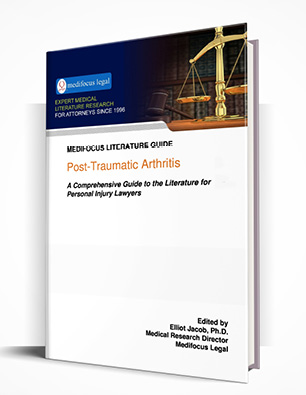Post-Traumatic ArthritisA Comprehensive Guide to the Literature for Personal Injury Lawyers
Publisher: Medifocus Legal
Publication Date: December 15, 2023
Number of Pages: 118
A Comprehensive Guide to the Literature for Personal Injury Lawyers
Publisher: Medifocus LegalPublication Date: December 15, 2023
Number of Pages: 118
Post-traumatic arthritis represents about 12% all osteoarthritis cases. The diagnosis of PTA is based upon a history of trauma to an affected joint, signs and symptoms, and imaging studies such as X-rays and MRI. In establishing the diagnosis, it is important to differentiate between PTA, where the etiology is trauma, and other types of arthritis (e.g., rheumatoid; degenerative; septic) which have different underlying pathological mechanisms. Although the pathophysiology of PTA is not well understood, inflammation secondary to trauma is thought to play a significant role. Typically, PTA resolves spontaneously within 2 to 3 months. The persistence of symptoms for 6-months or longer, known as chronic PTA, is believed to represent an ongoing inflammation of the traumatized joint.
The primary goals of PTA treatment are to minimize the symptoms, including pain, as well as to minimize loss of function of the affected joint. The initial approach to treatment includes medications, such as antiinflammatory agents or intra-articular injections of cortisone. Patients with PTA may also benefit from one or more courses of physiotherapy, which typically includes range of motion and strengthening exercises. Although these conservative treatments can help to better control PTA symptoms, they are not curative. Surgical management may be considered for those patients who do not respond adequately to conservative therapy. Surgical treatment of PTA may include debriding, reconstructing, or replacing the damaged joint surfaces.
The MediFocus Literature Guide to Post-Traumatic Arthritis captures a vast body of medical and scientific literature published in well-respected journals regarding the mechanisms of injury, risk factors, diagnosis, and medical/surgical treatment of PTA. This comprehensive literature Guide consists of over 150 hand-selected articles published in peer-reviewed journals with links to the article Abstracts and includes FREE online access to the full-text version of 42 articles. The Guide will serve as a valuable addition to the library of all personal injury attorneys involved in litigating PTA cases.
 |
- A comprehensive bibliography of 154 journal article references indexed in MEDLINE published in well respected medical and scientific journals.
- Online access to the abstracts (summaries) of the articles.
- Online access to the free full-text version of 42 articles.
- Links to full-text sources of other articles that are available for purchase directly from individual journal publishers.
- A unique "Author Directory" consisting of the names and institutional affiliations of experts who have published and have specialized knowledge about Post-Traumatic Arthritis. The "Author Directory" is a valuable resource for quickly identifying and locating experts for case reviews, opinions, and testimony.
Select examples of topics that are covered by the articles referenced in this Guidebook include:
- Post-traumatic osteoarthritis--a medico-legal minefield.
- Posttraumatic Arthritis After Intra-Articular Distal Femur and Proximal Tibia Fractures.
- Osteoarthritis: Trauma vs Disease.
- Post-traumatic osteoarthritis following ACL injury.
- Review of current understanding of post-traumatic osteoarthritis resulting from sports injuries.
- Inflammation in joint injury and post-traumatic osteoarthriti
- Post-traumatic osteoarthritis of the elbow.
- Post-traumatic ankle arthritis.
- The role of ACL injury in the development of posttraumatic knee osteoarthritis.
- Differences in the radiological characteristics between post-traumatic and non-traumatic knee osteoarthritis.
- Posttraumatic osteoarthritis: a first estimate of incidence, prevalence, and burden of disease.
- The development of posttraumatic arthritis after articular fracture.
- Trauma-induced concomitant psoriatic arthritis and complex regional pain syndrome.
- Pathomechanic determinants of posttraumatic arthritis.
- Sports, joint injury, and posttraumatic osteoarthritis.
- Traumatic arthritis of the hand and wrist in children.
- Posttraumatic ankle arthrosis.
- Total knee arthroplasty for post-traumatic arthrosis.
- Joint injury, repair, and remodeling: roles in post-traumatic osteoarthritis.
is available in two formats: | |
Order by Phone:To order by phone, please call: Order by Mail:To order by mail, please print and complete this Order Form | |

